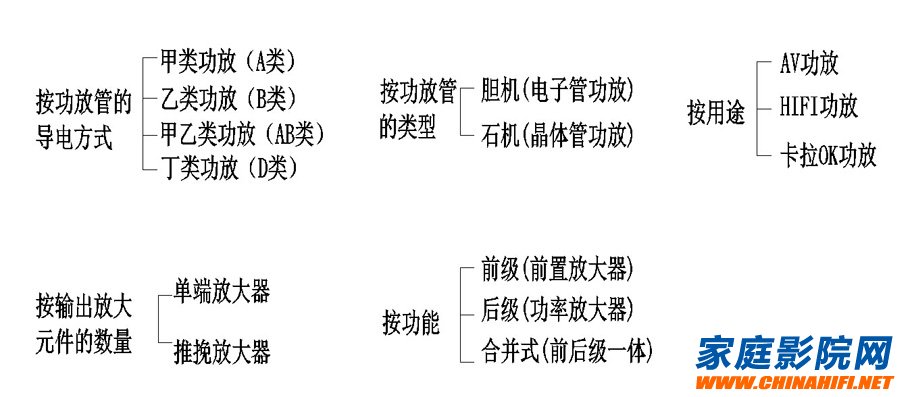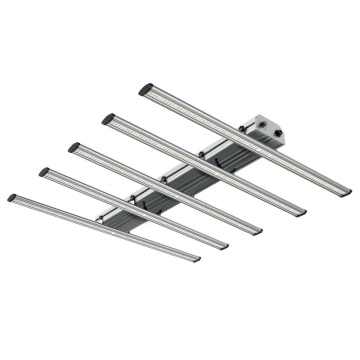
The home theater network () often hears people say Class A and Class B power amplifiers, as well as single-ended pushes. At least the author of the burnt is often confused. The reason is that there are too many classification standards for power amplifiers, and the classified power amplifiers are interspersed with each other. Deliberately made a picture, a clear classification of power amplifier, I hope to help everyone.

The picture is over. If you want to know more about the classification, please see below.
According to the different conductivity modes of the power amplifier tube in the power amplifier, it can be divided into Class A power amplifier (also known as Class A), Class B power amplifier (also known as Class B), Class A and Class B power amplifier (also known as Class AB) and Class D power amplifier (also known as D). class).
Class A power amplifiers are amplifiers that do not exhibit current cut-off (ie, stop output) for any power output component of the amplifier over the entire period of the signal (both positive and negative sine waves). Class A amplifiers generate high heat during operation and are inefficient, but the inherent advantage is that there is no crossover distortion. Single-ended amplifiers are Class A working methods, and push-pull amplifiers can be Class A or Class B or Class A.
Class B power amplifier refers to a type of amplifier in which the positive and negative sinusoidal signals are amplified by two "arms" of the push-pull output stage, and the conduction time of each "arm" is half a cycle of the signal. Class B amplifiers have the advantage of high efficiency and the disadvantage of crossover distortion.
Class A and Class B power amplifiers are between Class A and Class B. Each "arm" conduction time of push-pull amplification is greater than half a cycle of the signal and less than one cycle. Class A and Class B amplification effectively solve the crossover distortion problem of Class B amplifiers, and the efficiency is higher than that of Class A amplifiers, so it has been widely used.
D-type power amplifiers, also known as digital amplifiers, use extremely high-frequency switching circuit to amplify audio signals, which has the advantages of high efficiency and small size. Many D-type amplifiers with powers up to 1000W are just as large as VHS tapes. These amplifiers are not suitable for use as broadband amplifiers, but have many applications in active subwoofers.
According to the number of amplifiers in the output stage of the power amplifier, it can be divided into a single-ended amplifier and a push-pull amplifier.
The output stage of a single-ended amplifier is amplified by two a half cycles of positive and negative signals by an amplifying element (or multiple components but in parallel). Single-ended amplification machines can only take Class A work status.
The output stage of the push-pull amplifier has two "arms" (two sets of amplifying elements). When the current of one "arm" increases, the current of the other "arm" decreases, and the states of the two are alternately switched. For the load, it seems that an "arm" is pushing, and an "arm" is pulling to jointly complete the current output task. Although Class A amplifiers can be push-pull amplifiers, it is more common to use a push-pull amplifier to form a Class B or Class A amplifier.
According to the type of power amplifier tube in the power amplifier, it can be divided into a amp and a stone machine.
A amp is an amplifier that uses a tube.
The stone machine is a power amplifier that uses a transistor.
According to different functions, preamplifier (also known as preamplifier), power amplifier (also known as post-stage) and combined amplifier.
The power amplifier is referred to as a power amplifier, and is an electronic device for enhancing the signal power to drive the sound of the speaker. A power amplifier without an accessory function such as source selection and volume control is called a post stage.
The preamplifier is the preamplifier and control section of the amplifier before it is used to enhance the voltage amplitude of the signal, providing input signal selection, tone adjustment and volume control. The preamplifier is also called the preamplifier.
An amplifier that mounts both preamplifier and power amplifier in the same chassis is called a combined amplifier. The amplifiers that are common in our homes are generally combined.
According to different purposes, it can be divided into AV power amplifier and Hi-Fi power amplifier.
AV amplifiers are amplifiers designed for home theater use. They typically have more than 4 channels and surround sound decoding with a display. This type of power amplifier aims to make the audience experience the cinema effect by realizing the sound environment of the film environment.
Hi-Fi amplifiers are amplifiers designed to reproduce the true colors of music with high fidelity. They are generally two-channel and have no display.
According to the different components used, the power amplifier has "amplifier" [tube amp], "stone machine" [transistor power amplifier], "IC power amplifier" [integrated circuit power amplifier]. In recent years, due to the use of new technologies and new concepts in the amplifier, the ancient vacuum device of the electron tube has been splendid, and its beautiful sound has caused many fans to fall. Almost all experienced enthusiasts have one. "IC Amplifier" rarely sees his shadow in the HI-FI amplifier because his tone is not comparable to the two amplifiers.
According to the application field, the power amplifier can be divided into three major categories: “professional power amplifierâ€, “civil power amplifier†and “special power amplifierâ€.
Professional power amplifiers are generally used for conference, performance, hall, hall, field, and hall amplification. The design is based on large output power, perfect protection circuit, and good heat dissipation. Most of the "professional power amplifier" sounds are used for HI- When the FI is played back, the sound is hard to listen to.
The "Civil Amplifier" detailed classification includes "HI-FI power amplifier", "AV power amplifier", "KALAOK power amplifier" and a so-called "comprehensive power amplifier" that integrates various commonly used functions.
"HI-FI amplifier" is the amplifier of our enthusiasts, and its output power is generally below 2X150W. The design is based on "beautiful tone, high fidelity". A variety of high-tech is concentrated in this power amplifier. Prices range from a few thousand yuan to several hundred thousand yuan. "HI-FI power amplifier" is divided into "split type" [individually separate the preamplifier], and "combined" [integrate the preamplifier and the rear unit]. Generally speaking, in the same grade model, the "split type" is higher than the "merger" in terms of signal-to-noise ratio and channel division degree [not absolute]. And it is easy to make a sound through the signal line. The combined machine has the advantages of convenient use and low cost. The output power of the cheaper combined machine is generally designed to be below 2X100W, and many manufacturers produce high-end combined machines of 2X100W or more.
"AV" amplifier is a black horse that has emerged in recent years. With the popularity of large-screen TVs and various image carriers, the demand for "sitting at home to watch movies" is increasing, so various audio-visual functions are An integrated multi-function amplifier came into being. "AV" is the English AODIOVIDIO audio, the initials of the video. "AV power amplifier" from birth to the present, experienced the process of Dolby Surround, Dolby Pro Logic, AC-3, DTS, AV amplifier and ordinary power amplifier, the AV amplifier has AV select Dolby directional logic decoder, AC-3, DTS decoder, and five-channel power amplifier. And the digital sound field [DSP] circuit that adds the finishing touch to provide different sound field effects for various programs. However, since the AV power is placed on the signal circulation of the circuit, too many and complicated processing circuits have passed the "purity" of the sound, so the effect is not affected by the AV amplifier compatible with HI-FI playback. Ideal. This is why many HI-FI enthusiasts don't care about AV amplifiers.
"KALAOK amplifier" is also an amplifier developed in recent years. It differs from general power amplifiers in that "KALAOK amplifiers" have reverberators that have evolved from past BBD analog reverbs to the current DIGETAL digital reverberations], pitch shifters, and microphone amplifiers. In recent years, some manufacturers have combined the various functions including AV amplifier and KALAOK in order to meet the needs of the market. This is a so-called "comprehensive amplifier". This is a kind of hodgepodge, everything is there, and nothing is done. A kind of resistance to the countryside.
“Special power amplifiersâ€, as the name suggests, are power amplifiers used in special occasions, such as alarms, low-voltage power amplifiers for vehicles, etc., and will not be introduced here.
Power amplifier performance indicators
The main performance indicators of the power amplifier are output power, frequency response, distortion, signal to noise ratio, output impedance, damping coefficient and so on.
Amplifier output power: The unit is W. Since the measurement methods of different manufacturers are different, some names are different. For example, rated output power, maximum output power, music output power, peak music output power.
Amplifier music power: refers to the instantaneous maximum output power of the power amplifier to the music signal under the condition that the output distortion does not exceed the specified value.
Power amplifier peak power: refers to the maximum music power that the power amplifier can output when the amplifier volume is adjusted to the maximum without distortion.
Amplifier rated output power: The average output power when the harmonic distortion is 10%. Also called the maximum useful power. Generally speaking, the peak power is greater than the music power, the music power is greater than the rated power, and generally the peak power is 5-8 times the rated power.
Power amplifier frequency response: indicates the frequency range of the power amplifier, and the unevenness in the frequency range. The straightness of the frequency response curve is generally expressed in decibels [db]. The frequency response of the home HI-FI power amplifier is generally 20Hz--20KHZ plus or minus 1db. The wider the range, the better. The frequency response of some of the best power amplifiers has been achieved 0--100KHZ.
Distortion: The ideal power amplifier should be a faithful reproduction of the input signal after it has been changed without any change. However, for various reasons, the amplified signal of the power amplifier is compared with the input signal, and different degrees of distortion are often generated. This distortion is distortion. Expressed as a percentage, the smaller the value, the better. The total distortion of the HI-FI amplifier is between 0.03% and -0.55%. The distortion of the power amplifier includes harmonic distortion, intermodulation distortion, cross distortion, clipping distortion, transient distortion, and transient intermodulation distortion.
Signal-to-noise ratio: refers to the ratio of the signal level to the various noise levels of the amplifier output, expressed in db, the larger the value, the better. The SNR of the general household HI-FI amplifier is above 60db.
Output Impedance: The equivalent internal resistance presented to the speaker, referred to as the output impedance.
The performance of a power amplifier does not necessarily prove to have a good tone, which is something that first-time fans must realize. This is also the pursuit of many enthusiasts to explore. WeChat: cnhifi.
Our spider grow light adpot Samsung and osram leds as light source, all the series is Full spectrum led grow lights.
The product can be fixed on the ceiling of shelves, or hangering installation.
We can supply the whole site solutions to place the best effect at the lowest cost. OEM & ODM is available.

400W Spider Grow Light, Grow Light 5 Strips,Grow Light Bar,Grow Light Shelf,Plants Grow Lamp
Shenzhen Zhenyang Century Technology Ltd. , https://www.growlightzy.com